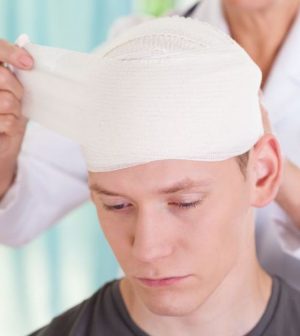- Skip Storing This Everyday Product in the Fridge Door
- Green Tea + B3 Pairing May Boost Brain Health
- Navigating Your Midlife Crisis: Embracing New Possibilities
- City Raccoons Showing Signs of Domestication
- Mapping the Exposome: Science Broadens Focus to Environmental Disease Triggers
- One Week Less on Social Media Linked to Better Mental Health
- Your Brain Changes in Stages as You Age, Study Finds
- Some Suicide Victims Show No Typical Warning Signs, Study Finds
- ByHeart Formula Faces Lawsuits After Babies Sickened With Botulism
- Switch to Vegan Diet Could Cut Your Greenhouse Gas Emissions in Half
Head Injuries Hit 1 in 14 Kids, CDC Reports

Given the news of the devastating effects of head injuries among professional football players, parents may wonder if their mini athletes are at risk, too.
Some very well might be, new research suggests.
About 7 percent of children 3 to 17 years old have experienced a head injury, according to U.S. health officials.
The findings are part of a report on children’s head injuries released Feb. 9 by the U.S. Centers for Disease Control and Prevention.
More boys (8 percent) than girls (6 percent) have had a significant head injury, according to the data. And the older kids are, the more likely they are to have had such an injury. Nearly 12 percent of 15- to 17-year-olds have had a significant head injury, the report showed.
This “suggests that as more children and teens engage in sports and other activities, the risk for a head injury also goes up,” said Dr. Robert Glatter, an emergency physician at Lenox Hill Hospital in New York City.
The good news, he said, is that most children with a concussion improve within two weeks. It’s not yet known if there are long-term effects from these injuries.
The CDC report included data from a nationally representative survey completed in 2016. Parents were asked if their children had ever had a concussion or other significant head injury.
However, the term “significant head injury” really doesn’t accurately describe what has occurred, said Dr. Karl Klamar, a physical medicine and rehabilitation specialist at Nationwide Children’s Hospital in Columbus, Ohio. Such injuries, he said, are forms of mild traumatic brain injury.
“Euphemisms like ‘seeing stars’ or ‘having your bell rung’ have diminished the seriousness of these injuries,” Klamar said.
He noted that most of these injuries occur during sports. Other causes include motor vehicle accidents, falls and, as kids get older, physical altercations.
One new cause of head injuries — and one that’s largely preventable — is a fall caused by distracted walking.
“Kids just aren’t paying attention to what’s in front of them,” Glatter said. “They’re looking at their phones and walking into light poles, windows and doorways.”
The CDC report found that white children and kids with parents who have more than a high school education are the most likely to sustain a head injury. Klamar said that’s probably because those kids have more access to sports.
What happens, then, when a child younger than 17 has a head injury?
“The results are phenomenally variable,” Klamar said. “Kids may experience symptoms for a few minutes to a few hours to a few months. Every injury is different.”
The severity of the injury also doesn’t always predict how quickly someone will recover from the injury, he said.
Short-term symptoms can include headaches, dizziness, problems with concentration and memory, irritability, anxiety and depression. Such symptoms can affect a child’s education and his or her ability to participate in school, according to Klamar.
“In terms of being able to make predictions about long-term effects, that’s something we’re not good at yet,” he said. “But it does seem that repeated blows may be more important.”
Glatter agreed. “You don’t have to have a concussion to cause damage,” he said.
You also don’t necessarily need head impact to sustain a concussion or brain injury, he said. Body contact can transmit force to the neck and head, he explained.
A possible bright spot in the data is that most kids who’d had a head injury — 81 percent — had just one significant head injury.
What can parents do to help their children avoid injuries?
“First, tell them to look up and know what’s going on in front of you,” suggested Glatter.
If your kids have a cellphone or tablet, be sure they’re aware of the importance of not using these devices when walking. “They need to focus on their environment,” he said.
Both experts said that using helmets in sports is crucial. Klamar emphasized always wearing a helmet for both competitive and recreational sports, such as ice skating, bike riding and sledding.
Klamar and Glatter also said kids need to wear a seat belt in all moving vehicles, including taxis. Younger children need to be in car seats or booster seats that are age- and size-appropriate, Klamar said.
“Size is probably the biggest factor,” Klamar said. “Children need to be at least 48 inches tall and at least 80 pounds before they’re out of a booster seat.”
More information
The U.S. Centers for Disease Control and Prevention has advice on preventing kids’ head injuries.
Source: HealthDay
Copyright © 2025 HealthDay. All rights reserved.










